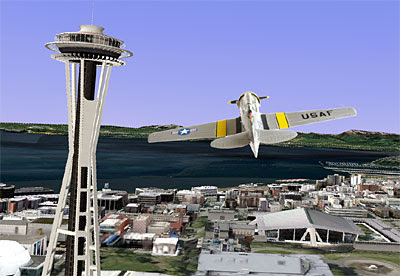 A lot of people learned to fly during WWII. That fed nicely into the idea promoted by small plane manufacturers that one day everyone could enjoy the freedom of flying their own plane. There was in fact a great development of air travel and personal flight opportunities, though the details and diversity went far beyond what was imagined during Flight's first half-century. As it turned out, commercial and technical developments, along with societal changes, pushed small planes toward ever-increasing performance and price. By the mid-'50s the Piper Cub had morphed into models with several times the range and capacities of the original. One of my last flights in a single engine aircraft - and by far the longest - was in a Piper Tri Pacer.
A lot of people learned to fly during WWII. That fed nicely into the idea promoted by small plane manufacturers that one day everyone could enjoy the freedom of flying their own plane. There was in fact a great development of air travel and personal flight opportunities, though the details and diversity went far beyond what was imagined during Flight's first half-century. As it turned out, commercial and technical developments, along with societal changes, pushed small planes toward ever-increasing performance and price. By the mid-'50s the Piper Cub had morphed into models with several times the range and capacities of the original. One of my last flights in a single engine aircraft - and by far the longest - was in a Piper Tri Pacer. In my second year at the University of Washington, my studies seemed to be taking me nowhere, so when an opportunity arose to join a project to make a film in the Amazon, I jumped in along with three other students. The group's leader was a tough little Greek guy who had just barely survived the Korean War and had ambitions to produce TV adventure stories. The photographer was a musician/biology student who happened to own a Speed Graphic and a 16mm Bolex. Transportation was provided by a pilot who had put in about four hundred hours in his Tri-Pacer. Since I had managed to struggle through several years of Spanish in my pre-college days, I was designated the interpreter. That was a good tip-off about the prospects of success for the venture.
 |
| Ahunt-Wikipedia |
As it turned out, the plane trip was the best part of the grand adventure. We took off from Seattle in December of 1959 with the objective of reaching the Amazon River in southern Colombia. Stops along the way included Mountain Home Idaho, Panguitch Utah, Nogales Mexico, Mexico City, Merida, Managua, Panama City, and Medellin in Colombia.

When we got to Bogotá aviation authorities there quite sensibly concluded that our going in the Tri-Pacer over hundreds of miles of rain forest to Leticia on the Amazon was a recipe for disaster. So, we left the little plane behind in Bogotá and made the final airborne leg of the trip in a C-46. From Leticia, we traveled a thousand miles by river launch up tributaries of the great River and did our filming along the way. But, that is another story, as is my very last flight in a single-engine aircraft.







































